Cerveteri › Chan Chan › The Marduk Prophecy » Origins and History
Articles and Definitions › Contents
- Cerveteri › Origins
- Chan Chan › Origins
- The Marduk Prophecy › Origins
Ancient civilizations › Historical places, and their characters
Cerveteri › Origins
Definition and Origins
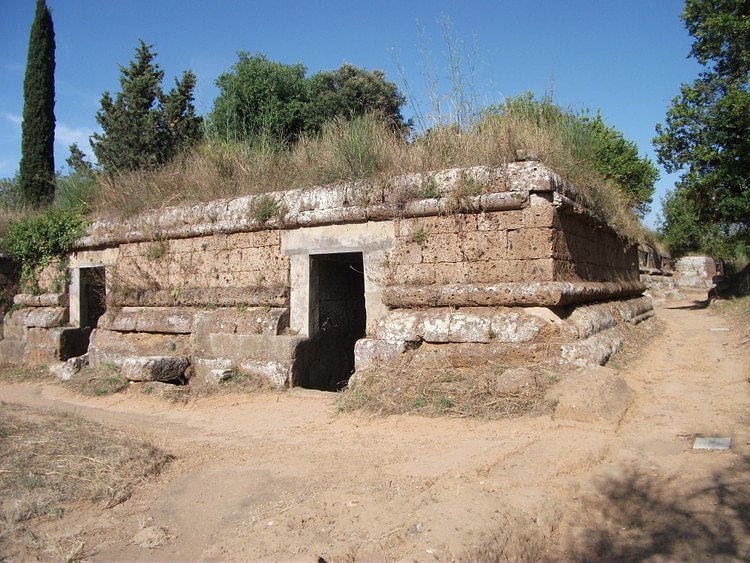
Cerveteri ( Etruscan name: Cisra or Caisra, Greek : Agylla, Roman : Caere) was an important Etruscan town which flourished between the 7th and 4th century BCE. Located near the western coast of central Italy, around 50 km north of Rome, Cerveteri is today most famous for its thousands of rock-cut tombs which were rich in artefacts and wall paintings depicting scenes from Etruscan daily life. Outstanding among these is the Regolini-Galassi tomb, found chock-full of precious artefacts from silver cups to the finest Etruscan gold jewellery ever discovered.
EARLY SETTLEMENT
Cerveteri, located on a tufa outcrop overlooking the Tyrrhenian Sea, has archaeological evidence of settlement from the Bronze Age and has cemeteries which date back to the Iron Age. Many of these latter burials contain instruments related to wool working such as spools, spindles and loom weights made of pottery and, less frequently, bronze. Blessed with fertile land for agriculture, mineral resources in the nearby Tolfa Mountains, and beginning to exchange goods with neighbours such as Tarquinia, Cerveteri was a thriving settlement of the pre- Etruscan culture known as the Villanovan (1000-750 BCE) and was set to become a prosperous town in the Etruria region of central Italy.
A THRIVING ETRUSCAN CITY
From the 7th century BCE, Cerveteri was an important production centre for the indigenous bucchero pottery (perhaps even the first, c. 675 BCE), which has a glossy dark grey, almost black finish, as well as wares imitating Greek (especially Ionian) and Near Eastern styles, sometimes made by Greek immigrant artists. The town's workshops produced its own distinctive vase shape, the Caeretan hydria, a large two-handled vessel used for holding water and often decorated with scenes from Greek and Etruscan mythology. Evidence of Cerveteri's position as a trade centre takes the form of the many fine Greek vases found at the site. The general prosperity of the city's elite is evidenced in the large tombs and their contents, placed within tumuli and set in orderly rows along streets. By the 6th century BCE, city covered some 150 hectares and was creating colonies of its own such as at Tolfa.
CERVETERI IS THE ONLY KNOWN ETRUSCAN CITY TO HAVE HAD ITS OWN TREASURY AT DELPHI, INDICATIVE OF ITS STATUS AS ONE OF THE RICHEST MEMBERS OF THE ETRUSCAN LEAGUE.
Etruscan Cerveteri is the only known city of that culture to have had its own treasury at the sacred site of Delphi in Greece, indicative of its status as one of the richest members of the Etruscan League. It had three ports: Alsium, Punicum, and Pyrgi with its two grand temples and sanctuary. One of these temples had three gold plaques nailed to its door, which were dedicated by a king of Cerveteri called Thefarie Velianas. The inscriptions, dating to around 500 BCE, were written in both Etruscan and Phoenician, again indicating the town's role as an international trade centre.
Cerveteri was a member of the Etruscan League, a loose confederacy of 12 (or perhaps 15) Etruscan towns. They included Chiusi, Populonia, Tarquinia (Tarchuna), Vulci (Velch) and Volterra. Very little is known of this league except that its members had common religious ties and that leaders met annually at the Fanum Voltumnae sanctuary near Orvieto (exact location as yet unknown). That Cerveteri was one of the most advanced Etruscan cities and something of a trendsetter is evidenced in finds of some of the earliest pottery, artwork, and inscriptions produced in the region of Etruria.
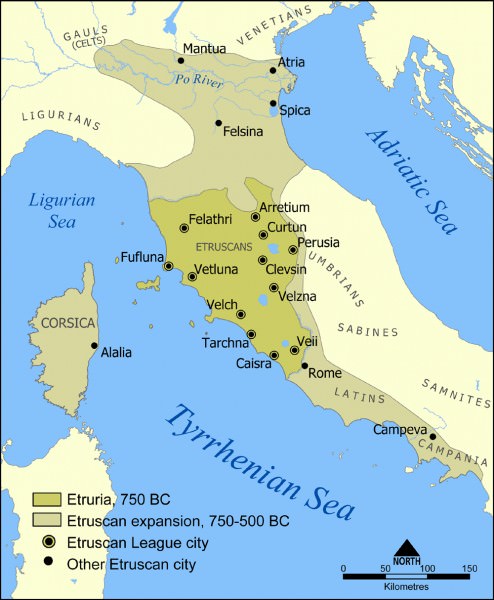
Etruscan Civilization
DECLINE & ROMAN CONQUEST
Cerveteri's interests were safeguarded following a naval victory in the Battle of Alalia (aka Battle of the Sardinian Sea) in 540 BCE. Allied with a Carthaginian force, they saw off a fleet of the Phocaeans. According to Herodotus (1:167), some of the Greek survivors were taken to Cerveteri and brutally stoned to death. There then followed a curse of paralysis on anyone who went near the spot of this tragedy. Seeking to allay the curse the rulers of Cerveteri consulted the oracle at Delphi and were told to hold athletic games in honour of the dead. This they did, says Herodotus, and continued to do so regularly thereafter.
A period of decline set in, though, from the mid-5th century BCE as control of the lucrative local trade routes fell into the hands of Sicily 's rising power Syracuse. The loss of the naval battle at Cumae in 474 BCE was the beginning of a slow decline.Then the Syracusan tyrant Dionysius I, no doubt remembering the Etruscan support of Athens ' attack on his city 30 years before, sent an expedition to central Italy to grab what riches it could. The ports of Cerveteri were sacked and the temples robbed of their treasures in 384 BCE. Further Syracusan attacks would hit Etruria in the following decades. Even worse was to come, however, when the Etruscan's southern neighbours started to show more territorial ambition too: the Romans were coming.
The Romans would exploit the lack of political and military unity between the Etruscan League members and eventually take over all of the Etruscan cities. Cerveteri had actually been a loyal ally of Rome, giving a safe haven for the Vestal Virgins, for example, when the Gauls had attacked Rome in the 4th century BCE. The cultural and military march of the Romans would stop for no one, though, and Cerveteri was assimilated into the Republic along with its fellow Etruscan cities after a long and bloody conflict punctuated by periods of peace. A Roman maritime colony was established at Pyrgi, and by the early 2nd century BCE Cerveteri's ultimate Romanisation included the granting of Roman citizenship, several building projects including a theatre, and the imposition of further Roman colonies in Cerveteri's former territories. Cerveteri became something of a cultural backwater, dedicating itself to agriculture and the production of cloth and rope. Gone forever were its glory days as one of the liveliest cultural centres of the ancient Mediterranean.
ARCHAEOLOGICAL REMAINS
To the south of the city, the foundations of two large temples have been excavated. Both dating to the 6th century BCE, one may have been dedicated to Hercules, if the presence of an inscribed cup and several clubs are taken as evidence of votive offerings to the god. Similarly, a lead weight inscribed with the Etruscan word for Hermes ( Turms ) may indicate the deity of the second temple. A third large structure, known as the Manganello temple, had a tufa block base, cisterns, water channels, wells, and a furnace, perhaps as part of workshop manufacturing votive goods.
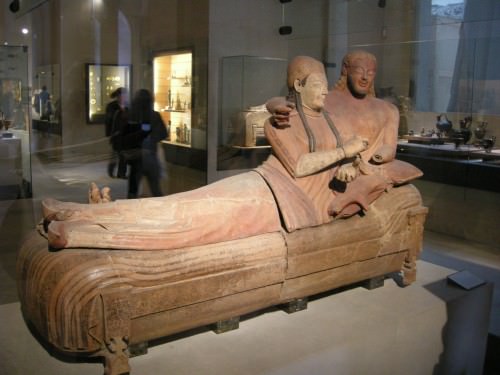
Sarcophagus of the Married Couple, Cerveteri
The thousands of rock-cut chamber tombs at Cerveteri are distributed over several cemeteries, the Banditaccia, Cava Della Pozzolana, Monte Abatone, and Sorbo, the latter dating back to the Iron Age. The earliest Etruscan tombs date to the 7th century BCE. Many are tumuli, that is grass and earth mounds covering a rock base, either made from blocks or cut out of natural outcrops. The largest are over six metres in diameter. Other kinds of tombs are the distinctive cube-like structures in the Banditaccia necropolis. These, dating from the mid-6th century BCE, are made from large stone blocks and, again, incorporate natural rocks; each has a single doorway entrance, and inside are stone benches on which the deceased were laid, carved altars, and sometimes stone seats. Set in rows, the tombs perhaps indicate a greater concern with town-planning at that time.
Unlike the tombs at Tarquinia, for example, many of the wall paintings at Cerveteri were applied directly to the stone walls without a plaster underlayer. This has meant that they have deteriorated much more than at other Etruscan sites.Nevertheless, there are still some fine examples of Etruscan art. Scenes commonly show Greek myths, animals, and daily life.
The splendid Tomb of the Stucco Reliefs was constructed for the Matuna family during the last quarter of the 4th century BCE.It is accessed via a steep stepped corridor which opens into a chamber with stone benches on all sides and places for 32 bodies. The chamber's two columns and walls are covered in painted stucco depictions of everyday objects from tools to boardgames. The objects hang from nails in imitation of the typical Etruscan household where storage cabinets are largely unknown and possessions were hung from the walls.
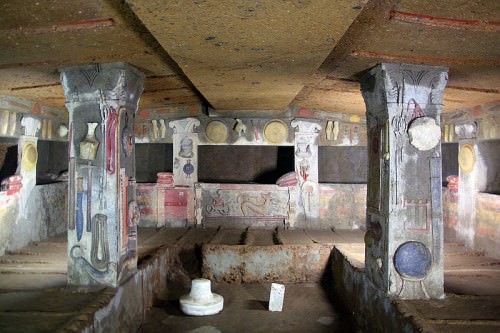
Tomb of the Reliefs, Cerveteri
Objects from the tombs of Cerveteri include many examples of exquisite gold jewellery pieces – bracelets, buckles, earrings, rings, pins, necklaces, and pendants – many of which display the most difficult goldwork techniques. There are buccherowares, painted pottery (both locally produced and imported, especially from Corinth and Athens), terracotta sculptures, and sarcophagi decorated with relief sculptures. One outstanding example of the latter, now in the Louvre museum, has a married couple figure sculpture on its lid and dates to c. 530-520 BCE. The terracotta coffin contained a cremation and was once brightly painted. Finally, many tombs contained painted terracotta plaques depicting scenes from mythology, especially.Fragments of these found scattered across Cerveteri would suggest that they were also used to decorate the interiors of private houses and public buildings.
THE REGOLINI-GALASSI TOMB
The most spectacular tomb in terms of finds at Cerveteri is the Tomba Regolini-Galassi, named after the priest and general, respectively, who discovered it in 1836 CE. The pair discovered the tomb intact and came face to face with the skeleton, bedecked in fine jewellery, of the tomb's female occupant. She wore a gold pectoral 42 cm across decorated with animals and plants, a symbol of her high social status. The woman also wore a belt with a magnificent gold fibula made with repoussé and granulation techniques. It is decorated with five lions on its upper disk and 50 minute ducks in three-dimensions on the lower disk. Whatever the role of this person was in life, we do know her name, Larthia, inscribed on an eleven-piece silver service set found at her feet. Neither was she interred alone in the tomb, for there was a second chamber containing the ashes of a male.
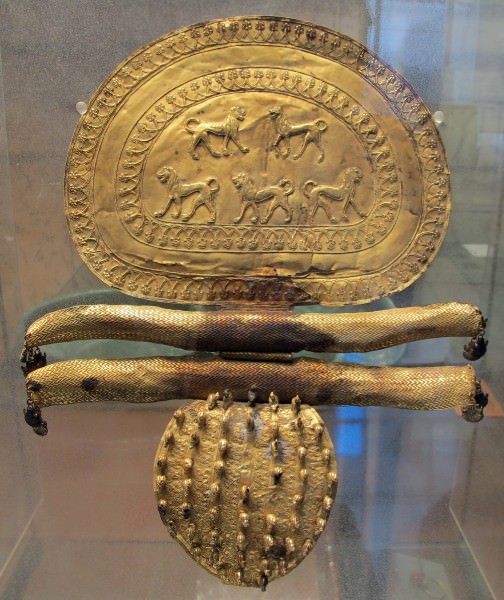
Etruscan Gold Fibula, Cerveteri
Other items in the tomb, many with near Eastern-like decoration include a large bronze couch; round shields, incense burners, cauldrons, and a throne in the same material; silver cups and dishes; and bucchero wares in the form of bowls, pitchers, and beakers. There were large terracotta vases which once contained food for the deceased (wheat, oil, honey, and eggs). Finally, there was a four-wheeled bed-carriage on which lay the woman of the tomb and another two-wheeled chariot. The contents of the tomb, dated to c. 680-660 BCE, can be seen today in its own dedicated room in the Vatican Museums, Rome.
Chan Chan › Origins
Definition and Origins

Chan Chan ( Chimor ) was the capital city of the Chimu civilization which flourished on the northern coast of Peru between the 12th and 15th centuries CE. The city was a giant metropolis populated by peoples from across the Chimu Empire, the largest the Americas had ever seen up to that time. Today, many of Chan Chan's huge palace complexes with their high relief-decorated adobe walls still survive as testimony to the city's lost grandeur.
HISTORICAL OVERVIEW
Chan Chan, also known as Chimor, the name of its original inhabitants, was built at the mouth of the Rio Moche from c. 1000 CE. The initial prosperity of the Chimu was largely due to their agricultural skills as they built an extensive irrigation system using canals. Later, their successful military campaigns and policy of extracting tribute ensured that they became the dominant regional power. At its height, Chan Chan covered some 20 square kilometres and had a population of up to 40,000 making it the largest city yet seen in the Andes. The city became the hub of a vast trade and tribute network, and no fewer than 26,000 craftsmen and women resided there, often forcibly removed from conquered territories, especially the Lambayeque, to mass produce high-quality goods for domestic consumption and export. Raw materials traded and controlled by Chan Chan included gold, spondylus shell, tropical feathers, and foodstuffs.
The traditional founding ruler of the Chimu was Taycanamo, who was considered to have been born from a golden egg and then arrived from the sea. Other notable rulers include Guacricaur, who expanded into the Moche, Santa, and Zaña valleys.Eventually, the Chimu extended their territory even further south and in 1375 CE, under the rule of Nancinpinco, conquered the Lambayeque ( Sican ) culture absorbing some of their cultural practices and artistic ideas. The La Leche Valley was also brought under Chimu control so that, at its height, the Chimu Empire was the largest and most prosperous in South America during the Late Intermediate Period. At its greatest extent during the reign of Minchançaman c. 1400 CE, the area of Chimu influence stretched 1300 kilometres along the coast of northern Peru. As the empire grew so other administrative centres sprang up, such as at Farfan, Manchan, El Milagro, Quebrado Katuay, and the fortress site of Paramonga, but Chan Chan was supreme as the centre of the Chimu world.
CHAN CHAN COVERED SOME 20 KM² & HAD A POPULATION OF UP TO 40,000 MAKING IT THE LARGEST CITY YET SEEN IN THE ANDES.
ARCHITECTURE
The city is without a recognisable centre and spreads out in a series of blocks interspersed with stone-lined canals and punctuated with small artificial lakes and wells. The architecture at Chan Chan is characterised by buildings constructed using pre-prepared sections of poured mud or adobe. Most impressive are the large rectangular palace compounds ( ciudadelas ) which served multiple functions as royal residence, storage facility, mausoleum, and administrative centre.
Ten royal palaces or compounds were constructed over the centuries at Chan Chan. It is possible that the Chimu system of royal inheritance was for each new king to inherit the title but not the wealth of his predecessor. This would result in a late ruler's family taking over the royal palace while the new king was required to build himself a new one, explaining the high number of such palaces at Chan Chan. The system has the added benefit of ensuring a new ruler actively engages in expanding the empire in order to fund his reign.
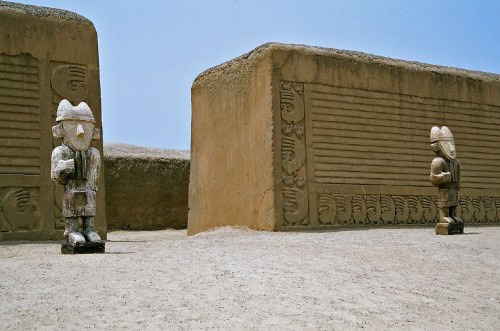
Adobe Walls, Chan Chan
The palaces were built in a rectangular layout, each with 10-metre high double exterior walls, labyrinthine interiors, and with only a single entrance guarded by two standing wooden statues set in niches. Of special note are the U-shaped audience or ritual rooms ( audiencias ) which controlled access to the storerooms. These are around 4 square metres, had elevated floors and, originally, gabled roofs. Functional structures within each compound include administrative and storage buildings and burial platforms accessed by a ramp. The large T-shaped tomb within the latter contained the mummified leaders while smaller tombs their family and entourage. Such tombs would have regularly been re-opened to inter new occupants. Over time the newer palaces became larger - the biggest covers an area of 220,000 square metres - and more space was dedicated to storage, indicative of the Chimu's imperial successes and policy of extracting tribute from conquered territories.
The walls of the compounds, built to restrict access by commoners, were decorated on the outside with bold relief designs, typically repeated geometric shapes, animals, and sea life, especially fish. The interior walls had niches for wooden decorative masks and figurines. Precious art objects would have been displayed here. The distinctive patterns cut into the walls may have been in imitation of those from textile wall hangings or basketwork. Similar adobe compounds were built at other Chimu sites, for example, nine at Manchan and six at Farfan. All of the compounds at Chan Chan are in the centre of the city, while more modest habitation lies on the city's outskirts. Here were the residences for administrators in miniature versions of the larger compounds, and artisans (metalworkers, woodworkers, and weavers), who lived in more modest dwellings of wattle-and-daub and cane with steep roofs and a single hearth. Finally, on the outskirts of the city, were two large burial pyramid -mounds known as Huaca el Dragon and Huaca Tacaynamo.
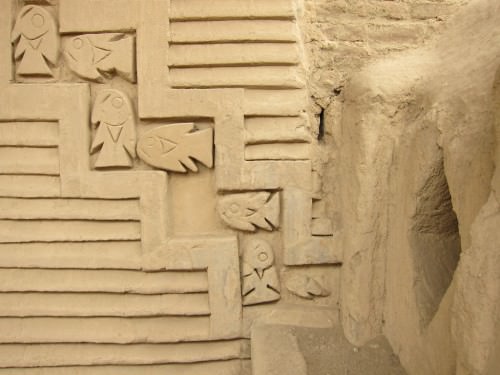
Wall Decoration, Chan Chan
THE FALL OF CHAN CHAN
Chimu architecture, their approach to regional governance, and their art would go on to influence their more famous successors, the Incas, who conquered Chan Chan c. 1470 CE. It was then that Tupac Yupanqui captured the 11th known Chimú ruler Minchançaman, who was kept permanent prisoner at Cuzco to ensure compliance to the new order. In addition, to control precious goods production and so limit the resources to fund rebellion thousands of Chan Chan artists and artisans were forcibly relocated to Cuzco. The Chimu thus became no more than a vassal state in the vast Inca Empire.
ARCHAEOLOGICAL FINDS
Chimu rulers were enthusiastic collectors of art from other cultures and their palaces were like museums full of niches in which objects and statues were placed for display. So too, rulers were buried with precious objects but, unfortunately, the site has suffered extensive looting, starting with the Incas. The Spanish, for example, describe melting down a covered doorway from Chan Chan to produce 500 kilos of gold. Post- conquest, Chan Chan has also suffered from El Nino rains, which have badly eroded the adobe brick buildings and walls over the centuries, some of which are now protected by permanent roofing.Nevertheless, finds include examples of the typical Chimu blackware ceramics, commonly in the form of effigy vessels or bulbous pots with spouted handles and incised decoration of geometric patterns. Surviving metalwork in the form of such items as gold earspools, feathered tunics, pendants of inlaid shells, miniature models of funeral scenes in wood and gold, and fine cotton textiles are all testimony to the skills of Chan Chan artisans.
The Marduk Prophecy › Origins
Ancient Civilizations
The Marduk Prophecy is an Assyrian document dating to between 713-612 BCE found in a building known as The House of the Exorcist adjacent to a temple in the city of Ashur. It relates the travels of the statue of the Babylonian god Marduk from his home city to the lands of the Hittites, Assyrians, and Elamites and prophesies its return at the hands of a strong Babylonian king. The original work was almost certainly written during the reign of Nebuchadnezzar I (1125-1104 BCE) as a propaganda piece. Nebuchadnezzar I defeated the Elamites and brought the statue back to Babylon, and the work was most likely commissioned to celebrate his victory.
The author would have constructed the narrative to place the events in the past in order to allow for a 'prophetic vision' in which the present king would come to restore peace and order to the city by bringing home the statue of the god. This form of narrative was commonplace in the genre now known as Mesopotamian Naru Literature where historical events or individuals were treated with poetic license in order to make a point. In a work such as The Curse of Akkad, for example, the historical king Naram-Sin (2261-2224 BCE), known for his piety, is presented as impious in an effort to illustrate the proper relationship between a monarch and the gods. The point made would be that if a king as great as Naram-Sin of Akkad could fail in piety and be punished, how much more would a person of lesser stature fare. In The Marduk Prophecy, the events are placed far in the past in order for the writer to be able to 'predict' the moment when a Babylonian king would return Marduk to his rightful home. This piece, then, also deals with the responsibility a monarch has to his god.
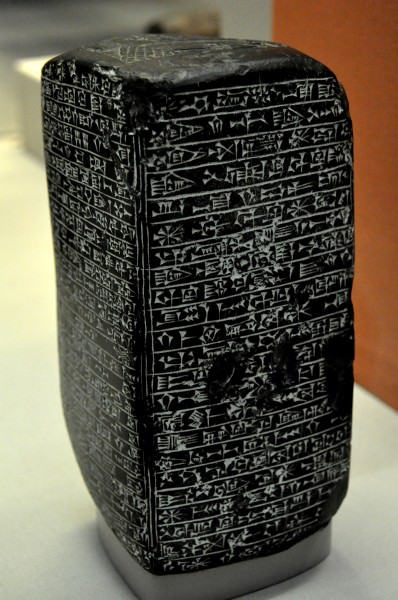
Stone Monument of Esarhaddon
In reading the text, one easily recognizes the mythical qualities and political themes - such as Marduk's statue expressing satisfaction with the lands of the Hatti and Assyrians - both considered allies or even closer - but distaste for the land of Elam - a traditional enemy of Babylon - but is also aware the work is drawing on actual historical events. The removal of a god's statue from a conquered city was common practice and was considered a devastating loss to the conquered. This was true of any god in any city but more so with Marduk and Babylon owing to their respective lofty reputations.
MARDUK KING OF THE GODS
In Mesopotamian mythology, Marduk was the son of Enki (also known as Ea), the god of wisdom, who became elevated to the position of king during a great battle between the forces of the older gods and those of their children. According to the Enuma Elish, the universe was originally a watery chaos until it divided into sweet water (known as Apsu, the male principle) and salt water (known as Tiamat, the female principle). Apsu and Tiamat then gave birth to the other gods who, with little to do, occupied themselves as best as they could.
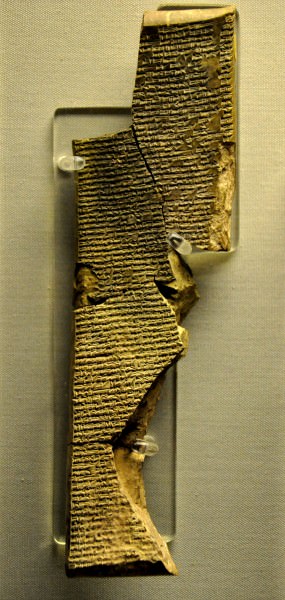
Mesopotamian Epic of Creation Tablet
In time, the antics of his children began to annoy Apsu who decided, on the advice of his vizier, to kill them. Tiamat, hearing of this, revealed the plot to Enki, who then moved first, put his father into a deep sleep, and killed him. Tiamat was horrified at this and raised an army to destroy her children. Led by her consort Quingu, the forces of Tiamat were victorious in every engagement. The younger gods were beaten back until Marduk stepped forth at a council meeting and announced he would lead them to victory if they would make him their king. Once they agreed, he defeated Quingu (who would later be executed) and killed Tiamat with a great arrow which split her in two.
Having defeated the forces of chaos, Marduk set about the creation of the world, the ordering of the heavens, and the formation of a new creature called a human being. Humans would be co-workers with the gods to hold back the forces of chaos and maintain order in the world. In this way, all humans were children of Marduk who worked to do his will. Marduk's story became so popular that he became recognized as the supreme god. Scholar Jeremy Black notes that "the worship of Marduk in its most extreme form has been compared with monotheism though it never led to a denial of the existence of other gods" (129). Marduk, then, was extremely important to the people of Mesopotamia but especially to those of the city of Babylon.
MARDUK'S IMPORTANCE TO BABYLON
Marduk rose to prominence as the patron deity of Babylon during the reign of Hammurabi (1792-1750 BCE) and continued to be venerated in the city up through the time of Persian rule until Babylon was destroyed in c. 485 BCE by Xerxes the Great.The New Year's festival (known as the Akitu Festival) could not be celebrated when the god's statue was absent from the city as this was thought to symbolize the departure of the actual god's presence. Marduk was thought to live in his temple in the center of the city just as the gods of other cities lived in theirs. When a god's statue was removed, the protection that deity afforded was lost as well. The Marduk Prophecy relates the kinds of conditions which followed when a god left or was taken from a city:
People's corpses block the gates. Brother eats brother. Friend strikes friend with a mace. Free citizens stretch out their hands to the poor to beg. The sceptre grows short. Evil lies across the land. Usurpers weaken the country. Lions block the road. Dogs go mad and bite people. Whoever they bite does not live, he dies. (Van de Mieroop, 48)
Scholar Marc van de Mieroop comments on this situation, writing :
The absence of the patron deity from his or her city caused great disruption in the cult [of that deity and city in general]. The absence of the divinity was not always metaphorical but often the result of the theft of the cult statue by raiding enemies. Divine statues were commonly carried off in wars by the victors in order to weaken the power of the defeated cities. The consequences were so dire that the loss of the statue merited recording in the historiographic texts. When Marduk's statue was not present in Babylon, the New Year's festival, crucial to the entire cultic year, could not be celebrated. (48)
Babylon was sacked by the Assyrian ruler Sennacherib (705-681 BCE) in 689 BCE after Sennacherib had earlier snubbed Marduk as god of the city as well as the ritual of 'taking the hand' of the god when he proclaimed himself king of Babylon.When he was assassinated by his sons in 681 BCE, it was considered Marduk's retribution for the insult to himself and his city.Sennacherib's successor Esarhaddon (681-669 BCE) went to great pains to distance himself from his father in rebuilding the city and honoring Marduk with an even grander temple, the great ziggurat of Babylon (model for the biblical Tower of Babel ) where, according to Herodotus, the people believed the god himself came down from the heavens to mate with specially chosen virgins who lived at the top level.

The Tower of Babel
Herodotus' claims aside, however, Marduk was understood to reside in his temple, not the heavens, among the people of his city. At the New Year's festival, his statue was paraded through the streets and out to a small house beyond the walls where he could enjoy a different view and some fresh air. Marduk was not a far off deity on some higher plane but instantly accessible and always available to the people. It was especially difficult for the Babylonians, therefore, when their protector and friend was taken from them.
MARDUK'S TRAVELS
The Marduk Prophecy gives no clear timetable of events, but it is now known, from other sources, when certain invasions took place and when the statue of the god was carried off. Further, the work does not follow the fate of the statue after it is returned to Babylon from Elam. A timetable of the travels of Marduk would run from the first time the statue was taken by the Hittites until its final destruction by the Persians under Xerxes, and this later history is supplied by Greek writers. The journey of the statue of Marduk would follow along these approximate dates:
c. 1595 BCE - Mursilli I of the Hittites carries the statue off to the Land of the Hatti after sacking Babylon.
c. 1344 BCE - Hittite King Suppiluliuma I possibly returns the statue to Babylon as a gesture of goodwill in trade (this is speculative).
1225 BCE - Tukulti Ninurta I of Assyria sacks Babylon and carries statue back to Ashur.
Although there have been some suggestions that the city of Ashur was sacked after Tukulti Ninurta I's death in 1208 BCE, this does not seem probable. The next time the statue is mentioned it is in the possession of Shutruk Nakhunte of Elam who most likely took it from the city of Sippar where it had been moved at some point.
c. 1150 BCE - Shutruk Nakhunte, King of Elam, acquires the statue in his sack of Sippar. Shutruk Nakhunte's inscription boasts of him destroying Sippar, a city near to Babylon, and carrying off many goods of religious and cultural value - including the stele of the great Naram-Sin - so it is probable that the statue had made its way to Sippar.
1125-1104 BCE - Reign of Nebuchadnezzar I who defeats the Elamites and brings the statue back to Babylon.
705-689 BCE - The statue remains in Babylon during Sennacherib of Assyria's reign until he sacks the city in 689 BCE and removes the statue, most likely to Nineveh.
681-669 BCE - Esarhaddon, Sennacherib's son, rebuilds Babylon, returns the statue, and honors Marduk with a new temple.
668-627 BCE - Reign of Esarhaddon's son Ashurbanipal during which the statue remains in Babylon.
c. 634 - c. 562 BCE - Reign of Nebuchadnezzar II during which the streets were widened so that the statue of Marduk could be more easily paraded on festival days and especially at the New Year when it would be carried out through the Ishtar Gateto the special house.

Model of the Ishtar Gate
c. 539 - Babylon is conquered by Cyrus the Great of Persia. Cyrus had great respect for the city and its god. An inscription on a clay barrel in Cyrus' tomb justifies his assault on Babylon and relates how Marduk was on his side and is due praise for his victory. The conquest of Babylon is justified in that Cyrus claims the king had forgotten due praise to Marduk and was unfit to rule.
c. 485 BCE - Babylon revolts against Persian rule and Xerxes I the Great destroys the city in retaliation, melting down the gold statue of Marduk.
THE RELIABILITY OF THE SOURCES
As noted, The Marduk Prophecy is historical fiction created to celebrate the victory over the Elamites of Nebuchadnezzar I. The sources which trace the fate of the statue following its return to Babylon are historical in nature, but the two central writers - Herodotus and Diodorus Siculus - have both been criticized for inaccuracies and outright fables in their respective works.Herodotus' accounts of Babylon have seemed suspect to readers since his own age, and Diodorus is responsible for the elaborate description of the Hanging Gardens of Babylon, which scholars now believe, if they existed at all, were at Nineveh.Both of these writers were vehemently anti-Persian, and a story of a Persian king destroying the statue of a god to teach a lesson to the people of a city he had just razed would have neatly furthered their respective agendas in portraying the Persians as insensitive, brutal, and impious.
THE MARDUK PROPHECY IS NOT SO MUCH RELEVANT AS HISTORY AS IT IS IN UNDERSTANDING THE GREAT VALUE THE PEOPLE OF A CITY PLACED ON THEIR PATRON DEITY.
The final fate of the statue of Marduk, then, according to the Greek writers, might well be suspect but for the fact that there is no more mention of the statue in any sources after Xerxes' assault on Babylon and no ancient writers contradict Herodotus' account. Babylon was taken by Alexander the Great when he conquered the Persian Empire in 331 BCE, and no mention is made of the statue nor is it ever mentioned in later accounts. It would seem, then, that Herodotus and Diodorus are correct in their conclusions unless some as-yet undiscovered source appears to present a different story.
The Marduk Prophecy is not so much relevant as history as it is in understanding the great value the people of a city placed on their patron deity. Marduk was not just some invisible, ethereal being one prayed to in time of need or praised in time of plenty, but a close friend and neighbor who lived just down the road. In the same way one would be distressed today to find one had lost a close friend, so was it to the ancient Babylonians when the statue of their god was taken from them.
LICENSE
Article based on information obtained from these sources:with permission from the Website Ancient History Encyclopedia
Content is available under License Creative Commons: Attribution-NonCommercial-ShareAlike 3.0 Unported. CC-BY-NC-SA License